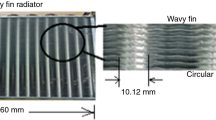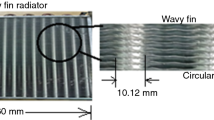Abstract
The performance evaluation of radiator with the application of a new coolant, water-based of various shape nanoparticles i.e., spherical (CuO), cylindrical (CNT), platelet (Graphene) and vol. concentrations based ternary hybrid nanofluid have been investigated theoretically. Impact of heat transfer rate and pressure drop along with exergetic analysis on vol. fraction of ternary hybrid nanofluid, coolant flow rate, and air velocity has been considered. Furthermore, the XRD and SEM morphology analysis have been conducted for 1% vol. fraction of ternary hybrid nanofluid. Theoretical comparative analysis revealed that the change in ternary hybrid concentrations plays a vital role in thermal performance due to its shape factor of nanoparticles. An increment of 19.35% and 7.2% in heat transfer rate and the second law of efficiency, respectively, were observed for variation in vol.fraction range within 1%–3% at 10 lpm. The application of ternary hybrid nanofluid increases the irreversibility of the system with coolant flow rate and air velocity. Entropy change for air is greater compared to entropy change in the coolants and results in a 29.15% increment in entropy change for ternary hybrid nanofluid. Similarly, an increase in air velocity also has the least effect on fan power. This inspection divulges on the particle shape and vol. concentrations both have a critical consequence on the accomplishment of ternary hybrid nanofluids in radiators, and its application is more effective in enhancing the thermal performance for an automotive cooling system.


















Similar content being viewed by others
Abbreviations
- CFR:
-
coolant flow rate
- C:
-
heat capacity rate (W/K)
- C*:
-
heat capacity ratio
- cp :
-
specific heat (J/kg.K)
- Da :
-
hydraulic diameter (m)
- G :
-
mass velocity (kg/m2s)
- J:
-
Colburn factor
- Fl :
-
longitudinal fin pitch
- Ft :
-
transverse fin pitch
- θ:
-
wavy angle
- r:
-
radius of curvature for wavy fin
- NTU:
-
number of heat transfer units
- h:
-
heat transfer coefficient (W/m2K)
- I:
-
irreversibility (W)
- Q:
-
heat transfer rate (W)
- Re:
-
Reynolds number
- k:
-
thermal conductivity (W/mK)
- Pr:
-
Prandtl number
- Gr:
-
Graphene nanoparticle
- CNT:
-
carbon nanotube
- m :
-
mass flow rate (kg/s)
- Nu:
-
Nusselt number
- PF :
-
fan power (W)
- p:
-
pressure (kPa)
- PP :
-
pumping power (W)
- PI:
-
performance index
- S:
-
entropy generation rate (W/K)
- T0 :
-
dead state temperature (K)
- T:
-
temperature (K)
- I* :
-
dimensionless exergy loss
- ∆p:
-
pressure drop (Pa)
- u:
-
air velocity (m/s)
- V:
-
volume flow rate (m3/s)
- U:
-
overall heat transfer coefficient (W/m2K)
- ∆Ex:
-
exergy gain or loss rate (W)
- ηo :
-
total heat transfer surface effectiveness
- η2 :
-
second law efficiency
- ρ:
-
fluid density (kg/m3)
- ε:
-
radiator effectiveness
- n:
-
shape factor
- a:
-
air
- hnf:
-
hybrid nanofluid
- i:
-
inlet
- e:
-
exit
- T-hnf:
-
Ternary hybrid nanofluid
References
Sarkar J, Ghosh P, Adil A (2015) A review on hybrid nanofluids: recent research, development, and applications. Renew Sust Energ Rev 43:164–177
Choi S (1995) Enhancing thermal conductivity of fluids with nanoparticles. In: Siginer DA, Wang HP (eds) Developments applications of non-newtonian flows, vol. FED-vol. 231/MD-vol. 66. ASME, New York, pp 99–105
Elias MM, Miqdad M, Mahbubul IM, Saidur R, Kamalisarvestani M, Sohel MR, Hepbasli A, Rahim NA, Amalina MA (2013) Effect of nanoparticle shape on the heat transfer and thermodynamic performance of a shell and tube heat exchanger. Int. Communication in Heat and Mass Transfer 44:93–99
Esfahani JA, Akbarzadeh M, Rashidi S, Rosen MA, Ellahi R (2017) Influences of wavy wall and nanoparticles on entropy generation over heat exchanger plate. Int J Heat Mass Transf 109:1162–1171
Ali HM, Ali H, Liaquat H, Maqsood HTB, Nadir MA (2015) Experimental investigation of convective heat transfer augmentation for car radiator using ZnO-water nanofluids. Energy 84:317–324
Ellahi R, Hassan M, Zeesan A (2015) Shape effects of nanosize particles in cu-H2O nanofluid on entropy generation, Int. Journal of Heat and Mass Transfer 81:449–456
Ellahi R, Hassan M, Zeeshan A (2015) Shape effects of nanosize particles in cu—H2O nanofluid on entropy generation. Int J Heat Mass Transf 81:449–456
Khairul MA, Alim MA, Mahbubul IM, Saidur R, Hepbasli A, Hossain A (2014) Heat transfer performance and exergy analyses of a corrugated plate heat exchanger using metal oxide nanofluids. International Communications in Heat and Mass Transfer 50:8–14
Sahu M, Sarkar J (2019) Steady-state energetic and Exergetic performances of single-phase natural circulation loop with hybrid Nanofluids. Journal of Heat Transfer, ASME. https://doi.org/10.1115/1.4043819
Alawi OA, Sidik NA, Wei Xian H, Kean TH, Kazi SN (2018) Thermal conductivity and viscosity models of metallic oxides nanofluids. Int J Heat Mass Transf 116:1314–1325
Hajabdollahi H, Hajabdollahi Z, Nomerical (2017) Study on impact behaviors of nanoparticle shapes on the performance improvement of shell and tube heat exchanger. Chem Eng Res Des 125: 449–460
Ghazali NM, Estelle P, Halelfadl S, Mare T, Siong TC, Abidin U (2019) Thermal and hydrodynamic performance of a microchannel heat sink with carbon nanotube nanofluids. J Therm Anal Calorim 138:937
Khan A, Ali HM, Nazir R, Ali R, Munir A, Ahmad B (2019) Ahmad Z (2019) experimental investigation of enhanced heat transfer of a car radiator using ZnO nanoparticles in H2O–ethylene glycol mixture. J Therm Anal Calorim 138:3007
Palaniappan B, Ramasamy V (2019) Thermodynamic analysis of fly ash nanofluid for automobile (heavy vehicle) radiators. J Therm Anal Calorim 136:223–233
Alsarraf J, Vo DD, Moradikazerouni A, Afrad M, Salehipour H, Qi C (2019) Numerical investigation of ϒ-AlOOH nanofluid convection performance in a wavy channel considering the various shape of nano additives. Powder Technol 345:649–657
Sheikholeslami M, Shehzad SA (2018) SCVFEM simulation for nanofluid migration in a porous medium using the Darcy model. Int J Heat Mass Transf 122:1264–1271
Sheikholesami M (2019) New computational approach for exergy and entropy analysis of nanofluid under the impact of Lorentz force through a porous media. Comput Methods Appl Mech Eng 344:319–333
Sheikholeslami M, Rezaeianjoubari B, Darzi M, Shafee A, Li Z, Nguyen TK (2019) Application of nano-refrigerant for boiling heat transfer enhancement employing an experimental study. Int J Heat Mass Transf 141:974–980
Sheikholeslami M, Haq R, Shafee A, Li Z, Elaraki YG, Tlili I (2019) Heat transfer simulation of a heat storage unit with nanoparticles and fins through a heat exchanger. Int J Heat Mass Transf 135:470–478
Sheikholeslami M, Haq R, Shafee A, Li Z (2019) Heat transfer behavior of nanoparticle enhanced PCM solidification through an enclosure with V-shaped fins. Int J Heat Mass Transf 130:1322–1342
Kumar V, Sahoo RR (2019) Viscosity and thermal conductivity comparative study for hybrid nanofluid in binary base fluids. Heat Transfer Asian Research:1–18. https://doi.org/10.1002/htj.21535
Kumar V, Sahoo RR (2019) Exergy, and energy analysis of a wavy fin radiator with variously shaped nanofluids as coolants. Heat Transfer Asian Research:1–19. https://doi.org/10.1002/htj.21478
Sheikholeslami M, Jafaryar M, Li Z (2018) Nanofluid turbulent convective flow in a circular duct with helical turbulators considering CuO nanoparticles. Int J Heat Mass Transf 124:980–989
Sheikholeslami M, Ghasemi A (2018) Solidification heat transfer of a nanofluid in the existence of thermal radiation by means of FEM. Int J Heat Mass Transf 123:418–431
Sheikholeslami M, Seyednezhad M (2018) Simulation of nanofluid flow and natural convection in a porous media under the influence of electric field using CVFEM. Int J Heat Mass Transf 120:772–781
Sheikholeslami M, Jafaryar M, Saleem S, Li Z, Shafee A, Jiang Y (2018) Nanofluid heat transfer augmentation and exergy loss inside a pipe equipped with innovative turbulators. Int J Heat Mass Transf 126:156–163
Sundar LS, Singh MK, Sousa AC (2014) Enhanced heat transfer and friction factor of MWCNT–Fe3O4 /water hybrid nanofluids. Int. Commun. Heat Mass Transf 52:73–83
Hussien AA, Yusop NM, Mohd AAN, Abdullah MZ, Janvekar AA, Elnaggar MH (2019) Numerical study of heat transfer enhancement using CuO–graphene/water hybrid nanofluid flow in mini tubes, Iranian journal of science and technology. Transactions A: Science 43(4):1989–1200. https://doi.org/10.1007/s40995-018-0670-1
Bahiraei M, Heshmatian S (2017) Efficacy of a novel liquid block working with a nanofluid containing graphene nanoplatelets decorated with silver nanoparticles compared with conventional CPU coolers. Appl Therm Eng 127:1233–1245
Madhesh D, Kalaiselvam S (2014) Experimental analysis of hybrid nanofluid as a coolant. Procedia Engineering 97:1667–1675. https://doi.org/10.1016/j.proeng.2014.12.317
Sahoo RR, Kumar V (2020) Exergy and energy performance for wavy fin radiator with a new coolant of various shape nanoparticle-based hybrid nanofluids. J Therm Anal Calorim. https://doi.org/10.1007/s10973-020-09361-z
Sahoo RR, Sarkar J (2017) Heat transfer performance characteristics of hybrid nanofluids as a coolant in louvered fin automotive radiator. Heat Mass Transf 53:1923–1931
Choudhary R, Khurana D, Kumar A. Subudhi S (2017) Stability analysis of Al2O3/water nanofluidsJ. Exp Nanosci 12: 140–151
Maxwell Garnett JC (1904) Phil. Trans. Soc. London R. Ser. A 203:385
Chamkha AJ, Miroshnichenko IV, Sheremet MA (2017) NumericalAnalysis of unsteady conjugate natural convection of hybrid water-based Nanofluid in a semi-circular cavity. ASME J. Therm. Sci. Eng. Appl., 9(4): 041004
Vaisi A, Esmaeilpour M, Taheria H (2011) Experimental investigation of geometry effects on the performance of a compact heat exchanger. Appl Therm Eng 31:3337–3346
Author information
Authors and Affiliations
Corresponding author
Additional information
Publisher’s note
Springer Nature remains neutral with regard to jurisdictional claims in published maps and institutional affiliations.
Rights and permissions
About this article
Cite this article
Rekha Sahoo, R. Effect of various shape and nanoparticle concentration based ternary hybrid nanofluid coolant on the thermal performance for automotive radiator. Heat Mass Transfer 57, 873–887 (2021). https://doi.org/10.1007/s00231-020-02971-1
Received:
Accepted:
Published:
Issue Date:
DOI: https://doi.org/10.1007/s00231-020-02971-1




